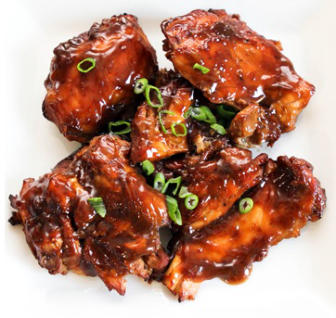Adobo is to the Philippines as curry is to India. Ask any 10 Filipinos how to make Adobo and you will likely
get 10 very good answers. Many say that Chicken Adobo is the national dish, reflecting influences from
Chinese, Spanish and indigenous cuisines.
Basically, adobo refers to a process where meat or fish is braised in vinegar and seasoned to
be both sweet and salty. The protein may also be stewed, deep fried, grilled, broiled or pan fried
to get the edges of the meat nice and crispy. It is most always served with the broth/sauce
created during cooking. The sharpness of the vinegar is softened by the length of time spent on
the fire.
Adobo is so popular that there are a few Filipino snacks which are labeled "adobo flavored"
including some nut, chip, noodle soup and corn cracker products.
Do not confuse this style of cooking with Spanish or Latin American adobo, which can
involve a non-vinegar based wet or dry spice rub. For example, Puerto Rican style adobo can be
a dry blend of spices which may include garlic powder, salt, black pepper, oregano and dried
citrus zest to be sprinkled on meats before cooking. Food stores sell prepared blends like this
under the Goya Foods brand, among others.
The Spanish invaded the Philippines in the late 1500’s and so they met with the Filipino
stewing process. They referred to this method as "adobo" since it is loosely similar to the
Spanish adobo, which is their word for marinade, sauce or seasoning.
What sets Filipino adobo apart is the use of vinegar as the major ingredient, along with the
use of Asian soy sauce. As you explore this recipe in your own kitchen you may find that having
too much vinegar can overpower the dish, making it too tart. Too little vinegar can dilute the
flavor. The soy sauce provides a salty counter to the sour vinegar. Have fun experimenting
according to your own tastes!
So here is another recipe from my sister-in-law Bernie, who is from the Philippines. She
grew up in San Juan, Metro Manila, and learned this family recipe from her mother. Bernie says
that the native Philippine vinegar is called "sukang paombong" but that she substitutes white
vinegar while her Mom prefers apple cider vinegar.

Chicken Adobo
Home | Indian Recipes | Thai Recipes | Main Dishes | Desserts | Leave a Comment | Recipes by Email | About
Copyright © Suzanne’s Recipe File | Privacy Policy



- Hot Chicken Salad
- Mom's Meatloaf
- Beef Stew
- Quesadillas
- Beef Stroganoff
- Chicken in Brandy & Cream Sauce
- Chicken Pot Pie
- Puff Pastry Pizza
- Chicken Parmesan
- Home Made Meatballs
- Pasta Carbonara
- Pancakes!
- Pasta in Garlic & Oil
- Pasta Alla Maddy
- Pork with Lychees and Coconut Sauce
- Pasta Sauce from Tomatoes
- Lasagna
- Pasta in Oil and Garlic Sauce
- Pork Tenderloin with Porcini Mushroom-Aprcot Sauce
- Braised Pork with Watermelon
- Pork Tenderloin with Green Curry
- Roasted Butternut Squash with Chickpeas
- Mushroom Sauce for Pasta
- Taco Seasoning
- Tacos with Carnitas of Pork
- Beef Chili with Beans
- Chili with Black Eyed Peas
- Broccoli Quiche
- Roast Chicken or Turkey
- Barbecued Pulled Pork Sandwich
- Barbecued Pork ribs
- Chicken Adobo
- Empanadas
- Honey Baked Ham
- Shepherd's Pie
- A Complete Holiday Dinner
►Home- All Recipes
►Main Dishes
►Hot Chicken
Salad
►Mom’s Meatloaf
►Beef Stew
►Quesadillas
►Chicken in Cream
Sauce
►Braised Pork with
Watermelon
►Chicken with Goat
Cheese
►Chicken Adobo
►Chicken Pot Pie
►Pork with Coconut
Sauce
►Puff Pastry Pizza
►Spiced Chickpeas
with Roasted
Butternut
Squash
►Grilled Pork
Tenderloin with
Mushroom
Sauce
►Green Curry Pork
Tenderloin
►Chicken
Parmesan
►Home Made
Meatballs
►Pasta Carbonara
►Lasagna
►Pancakes!
►Pasta Alla Maddy
►Tomato Pasta
Sauce
►Pasta in Garlic
and Oil
►Marinara Sauce
►Mushroom Pasta
Sauce
►Coconut Chili
Sauce
►Empanadas
►Barbecued Ribs
►Barbecued Pulled
Pork
►Beef Chili with
Beans
►Chili with Black-
Eyed Peas
►Taco Seasoning
►Pork Carnitas
Tacos
►Broccoli Quiche
►Roast Turkey or
Chicken
►A Complete
Holiday Dinner
►Honey Baked
Ham
►Shepherd’s Pie
►Leave a Comment
►Get Recipes by
Email













